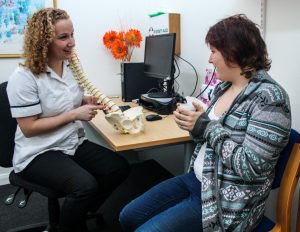by Sarah Williams
Sciatica is one of the most talked about conditions in a chiropractic setting and is often a term used to describe anything from back pain to leg pain to hip and/or groin pain, but what actually is sciatica?
Sciatica is a term coined with the sciatic nerve, the longest nerve in your body, formed by the union of 5 nerve roots at the base of your spine. From your low back your sciatic nerve will then pass down the back of your leg and travel as far as the sole of your foot.
When sciatica is discussed it is most commonly implied the nerve has been “trapped” or that the “disc has bulged”. However, true sciatica is actually defined as the irritation of these nerve roots and/or the compression of the sciatic nerve, which is more accurately diagnosed as a type of “lumbar radiculopathy”.
What causes the irritation and compression will vary greatly and won’t necessarily involve a “disc bulge”. Symptoms of true sciatica can include sharp pain, burning pain, shooting pain, stabbing pain, numbness, weakness and other sensory changes. True sciatica must include symptoms in the leg, there can be symptoms elsewhere such as the low back but this is not essential for diagnosis.
It is very common coughing and sneezing will aggravate these symptoms, as well as some positions being unbearable due to increased tension on the nerve roots. A lot of true sciatica can be managed conservatively with anti-inflammatory medication, rest, ice and manual therapies (such as chiropractic care).
Unfortunately in some cases there will need to be surgical intervention, and complications may develop without it. This is hugely dependant on the source of irritation/ compression, time factors, additional medical history, previous history of back pain and current severity of symptoms.
True sciatica is fairly uncommon. Today sciatica is used more as an umbrella term to describe pain in the low back, leg, hip and/ or groin. What do you have if it’s not true sciatica? Honestly, it can be so many things, there is a very long list of conditions associated with low back, leg, hip and/ or groin pain.
Take a moment to think what your low back comprises of:-
- 5 lumbar vertebrae- all with complex joints, allowing them to move efficiently
- The sacroiliac joint – essentially the back of your pelvis but don’t be fooled by the simplicity of its location, how it allows us to move is incredibly complex and unlike any other joint in the body
- The coccyx – just below your sacroiliac joint, known as our tailbone
- Ligaments – to keep our joints together to prevent injuries such as dislocations
- Muscles- and lots of them in your low back and legs
- Tendons- to connect muscles to bones
- Discs- that act like cushion between our vertebrae
Then take into account:-
- Age
- Sporting history
- Mobility in general (stiff, flexible)
- Any previous injuries or traumas
- Occupational factors
- Sleeping patterns
- How long you are sat down each day.
Your body is constantly under load, therefore most commonly we see pain arising from a combination of these structures not working correctly.
How do you find out which one you have? Whether it is true sciatica or sciatica like symptoms it is always worth seeking advice as soon as possible whether it’s with ourselves, another chiropractor, osteopath, physiotherapist or a GP. You will be able to find out your diagnosis, but most importantly find out the most appropriate treatment route to ensure the best recovery.




